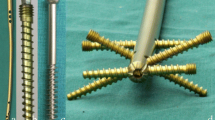Summary
Between January 1993 and December 1995 we treated 109 patients (median age: 75 years) with 112 extraarticular hip fractures including combined trochanteric and shaft fractures using two different “sliding-screw-nail implants” (intramedullary hip screw = classic nail: n = 61; gamma nail: n = 51). Comparing the two systems in detail certain advantages and disadvantages were seen, with both being equivalent. We encountered the following complications: secondary varus malalignment of the collum femoris with “cut out” of the sliding-screw (1.8 %) and without “cut out” (1.8 %), fissure of the femoral shaft occuring intraoperatively and being treated conservatively (1.8 %), femoral perforation by the nail (0.9 %), infection (2.7 %). Thus, 5 reoperations (4.5 %) were necessary. None of these complications were attributable to the principle itself or to the different implants used. Each patient was followed-up for a minimum of 12 months postoperatively. In 59 % of all patients the pre-trauma range of mobility could be fully restored. Intramedullary hip screw and gamma nail are excellent and equivalent systems, which fully satisfy the biomechanical needs of above mentioned fractures.
Zusammenfassung
Zwischen Januar 1993 und Dezember 1995 haben wir bei 109 Patienten (Altersmedian 75 Jahre) insgesamt 112 extraartikuläre Frakturen des proximalen Femurendes einschließlich Kombinationsfrakturen Schaft – Trochanterregion in Serie mit unterschiedlichen „Gleitschrauben-Nagel-Implantaten“ [61 classic nail (IMHS), 51 γ -Nägel (GN)] versorgt. Beim Systemvergleich zeigten beide Implantatvarianten im Detail Vor- und Nachteile, erwiesen sich jedoch prinzipiell als gleichwertig. Komplikationen in Form von sekundärer Schenkelhalsvarisierung mit „cut-out“ (1,8 %) und ohne „cut-out“ (1,8 %) der Gleitschraube, 2 intraoperativ erzeugten und konservativ behandelten Schaftfissuren (1,8 %), einer Nagelperforation des Femur (0,9 %) sowie 3 Infekten (2,7 %) machten insgesamt 5 Reoperationen (4,5 %) nötig, wobei keine dieser Komplikationen dem Prinzip selbst oder den Implantatvarianten anzulasten ist. Alle Patienten wurden mindestens bis zum Ende des 1. postoperativen Jahres weiterverfolgt, 59 % der Patienten erreichten ihre Ausgangsmobilität wieder. IMHS und GN sind ausgezeichnete und gleichwertige Implantate, die den biomechanischen Anforderungen der obengenannten Frakturformen genügen.
Similar content being viewed by others
Author information
Authors and Affiliations
Rights and permissions
About this article
Cite this article
Wagner, R., Blattert, T. & Weckbach, A. Solution for extraarticular hip fractures using the “sliding-screw-nail”-principle. Results of two different systems (classic nail and gamma nail). Unfallchirurg 101, 894–900 (1998). https://doi.org/10.1007/s001130050355
Published:
Issue Date:
DOI: https://doi.org/10.1007/s001130050355




